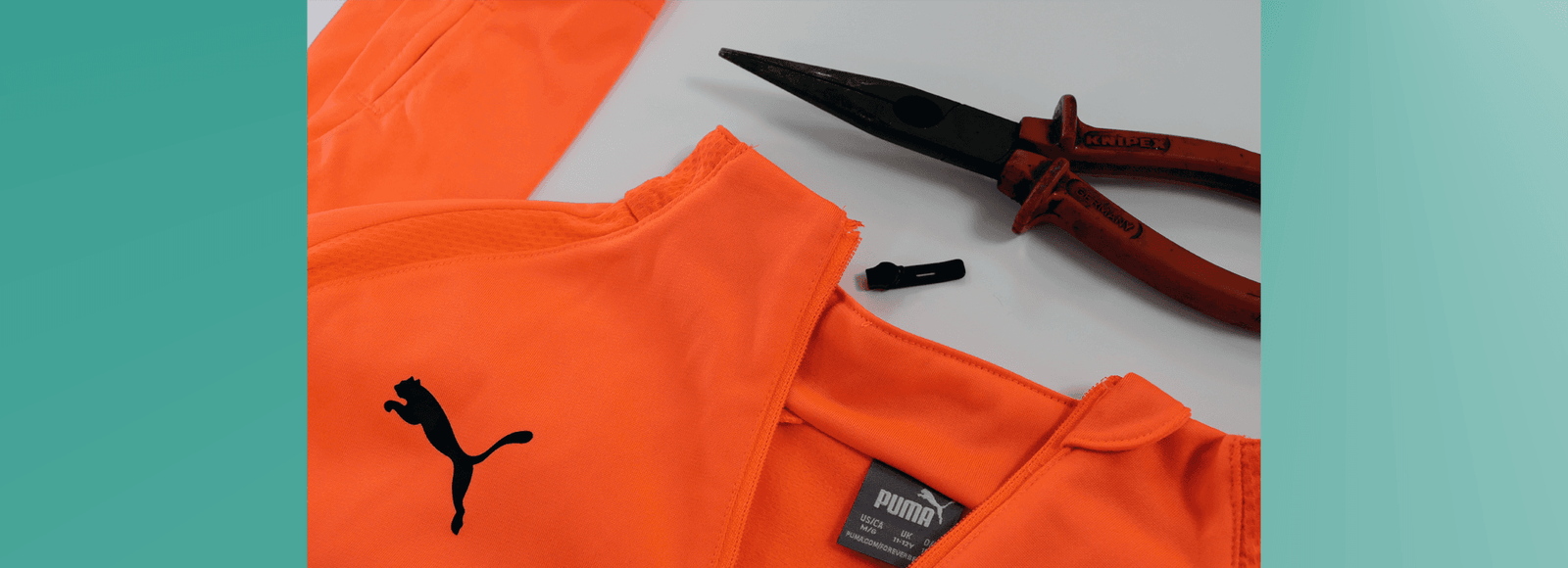
How to Fix a Zipper that Came off
It can be frustrating, and costly, when you pull a zipper off your favourite jacket, so knowing how to fix a zipper that came off is a neat skill to have.
Not to mention the positive environmental impact you will have by not throwing away the piece of clothing just because of a broken zipper!
Believe it or not, fixing that zipper at home is easier than you thought.
In this blog we are going to show you how to do just that and all you need is pair of pliers and some top stops or square tabs to get your zipper moving again.
We’ll show you how to fix your zipper slider, as well as quick fixes to complete the fix and keep the slider in place.
Your zipper will function normally once again.
How to Fix a zipper that came off
Removing Zipper Teeth to Get the Pull Back On

-
If your zipper pull is broken, buy a new one.
- You’ll need to purchase a replacement slider if the one you already have is damaged and not functioning properly. A replacement zipper slider can be purchased from a craft store.
- For optimum results, be sure to purchase a replacement zipper pull that is the same size and design as your previous one. Bring the previous one along so you can compare.
Most craft stores also provide zipper repair kits that come with everything you need to replace the pull, add top stops, and add square tabs as necessary. The new zipper pull, stop tabs, and/or top stops must be purchased separately in the event of a malfunction.
2. Use pliers to remove the zipper’s teeth from the end.

You will need to remove some of the fabric from the zipper’s end in order to reattach it. With the use of a pair of pliers, remove each zipper tooth one at a time. Once the fabric has been exposed by roughly 2″ to 3″ (5 cm to 7.6 cm), stop removing teeth. <2>
- The least quantity of fabric must be exposed in order to reattach the zipper pull. This will be nearer 3″ if you have a large zipper pull (7.6 cm). If your zipper is small, you might only be able to expose a couple of inches.
- Before you remove the teeth, think about the condition of the zipper. If the zipper is wide open, you must remove the teeth at the zipper’s base. You must remove the teeth from the top of the zipper if the zipper is closed.
- Make sure the cloth is exposed to the same degree on both sides of the zipper. You can have trouble putting the pull back if not.
3. Place the zipper pull on the material.

Depending on whether the zipper was open or closed when it was removed, the pull will be in a different direction.
- In order to steer the pull away from the zipper if the zipper was open, slide the pull onto the fabric upside down.
If the zipper was shut, position the pull so that it faces the zipper and slide.
4. Pull on the zipper’s sides above the pull.

You must pull on both sides of the fabric above the zipper pull to move the zipper pull from the fabric section of the zipper to the zipper part of the zipper.
- As a result, tension will be produced, pulling the pull towards the zipper teeth.
Till you hear a click, keep pulling. This shows that the zipper pull is once more on the teeth.
5. Once the pull is attached again, check the zipper.

To test the zipper’s functionality, try moving it up and down a few times. It should be simple to zip up and down once the zipper is placed back on the teeth. You might need to start afresh and try again if it is crooked or not moving.
Before you attach the end with a fresh top stop or square tab, be sure the zipper does not zip off the track once more.
Part 2 Adding Top Stops and Square Tabs

-
Think about whether square tabs or top stops are preferable.
To stop your zipper pull from coming off the zipper again after removing some teeth, you will need to replace some of the teeth with top stops and/or square tabs.
- Top stops are tiny components that fit on one zipper side.
- Square tabs are more substantial components that span your zipper, bridging the gap between the zipper sides and preventing the zipper from falling down on both sides .
- The best zipper top stops are those that block the zipper slider from coming off again while still allowing you to open and close the zipper.
- The best zipper bottom stops are square tabs because they will stop a zipper from coming off and close the gap created by missing teeth. These tabs are also referred to as zipper bottom stops.
2. Using pliers, press a top stop onto the zipper.

Place the top stop directly above the first tooth at the top of your zipper if you want to add a top stop to prevent your zipper from coming off the slider at the top.
- You’ll need to have the zipper slightly open in order to achieve this. Use the pliers to crimp the top stop into place once you’ve placed it where you want it to be .
- As you pull on the top stop, be sure it is secure and won’t move or come off.
- To make sure the zipper won’t fall off the track once more, place top stops on both sides of it.
3. Place the prongs of the square tab.

Take a square tab and poke its prongs through the fabric of the zipper on both sides if you want to use it to fill the gap at the bottom of a zipper.
- Just below the zipper’s bottom teeth, insert the prongs. When doing this, make sure the zipper is closed. Turn the garment or fabric over after pressing the prongs through, then use your pliers to bend the prongs inward .
Make sure the prongs are firmly crimped down so that the tab is held in place and the prongs are flat. The prongs must be flat in order to avoid snagging or scratching objects on your skin.
4. Finito!

Conclusion
We hope you found this helpful and that it might save one more piece of clothing going to landfill.
Why not have a look at our Sustainability Hub while you’re hear?
You can learn about some of our Strategy and initiatives or check out our Sustainable products to buy.
